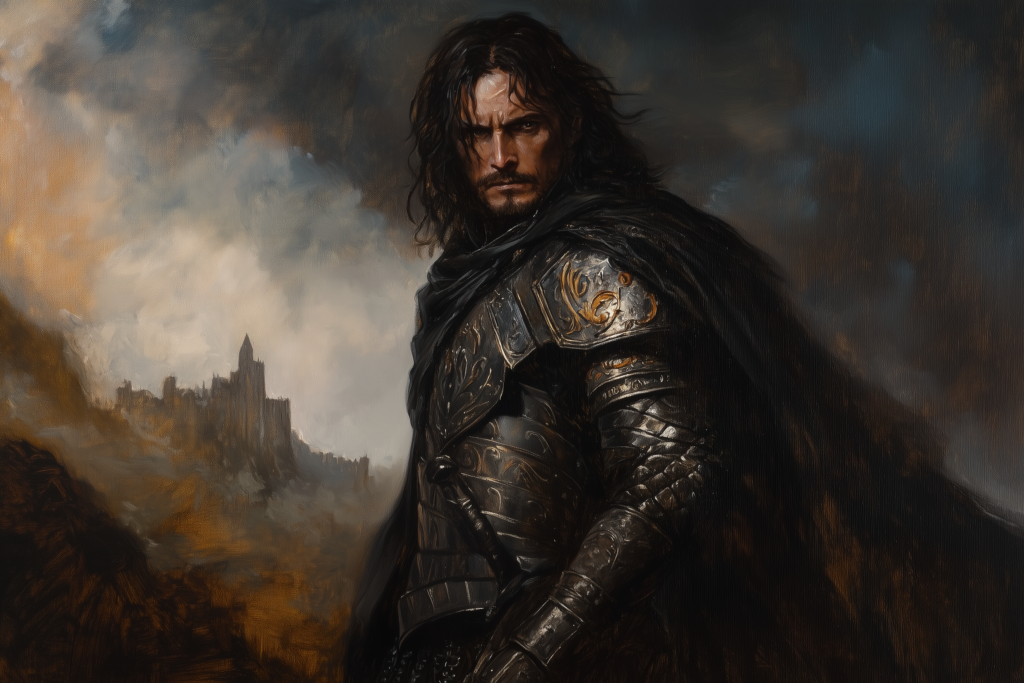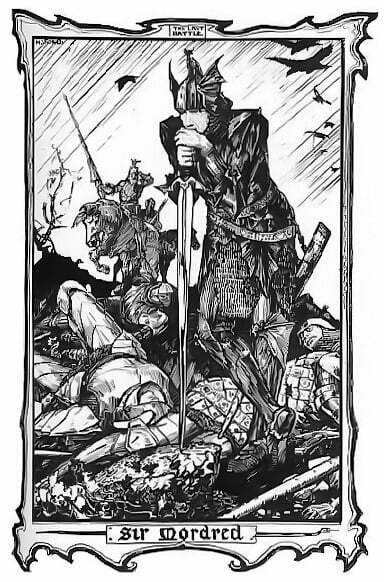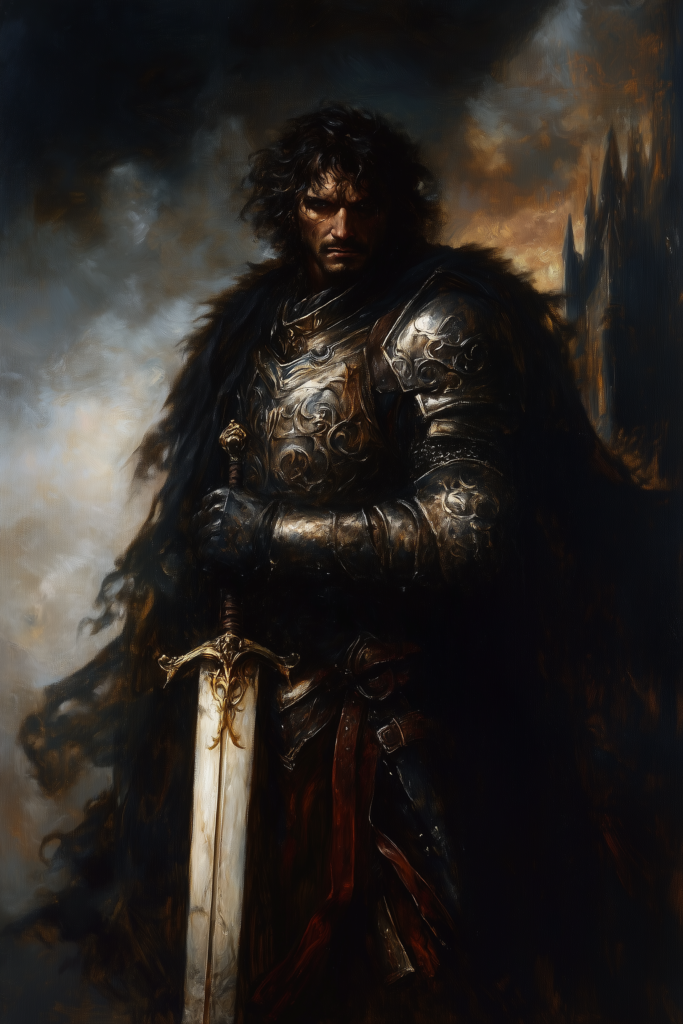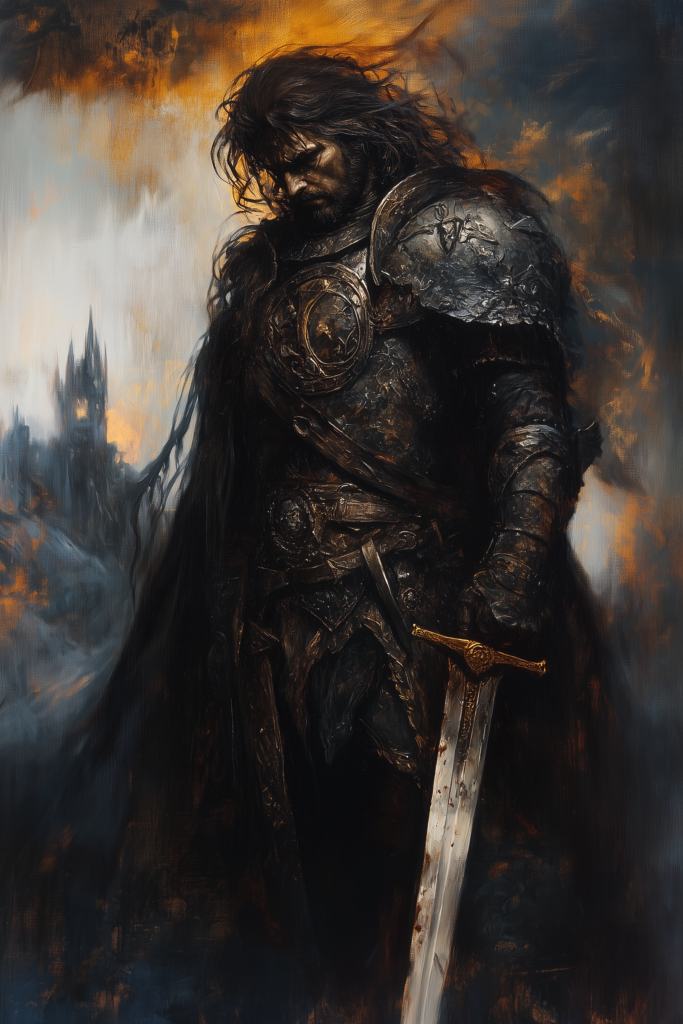Sir Mordred: The Cursed Heir of Camelot
“The cursed knight who betrayed King Arthur—was it ambition or fate that doomed Camelot?”

- Alias – The Cursed Heir, The Betrayer of Camelot, The Black Knight of Camlann
- Gender – Male
- Race – Human (sometimes depicted with fey or supernatural lineage)
- Occupation – Knight, Prince, Usurper of Camelot
- Religion – Paganism or Early Christianity (depending on the version of the legend)
- Allies – Morgause (mother), Morgan le Fay (in some versions), disillusioned knights and lords of Camelot, rebel factions
- Enemies – King Arthur, Knights of the Round Table, Sir Gawain (half-brother in some tales), Merlin
- Abode/Base of Operations – Camelot (briefly as usurper), Orkney (his homeland in some versions)
- Nationality – British (Celtic or Romano-British, depending on interpretation)
- Languages – Old English, Old Welsh, Latin (if historically contextualized)
- Alignment – Lawful Evil or Lawful Neutral (depending on interpretation)
- Affiliation(s) – Knights of the Round Table (formerly), Rebel Forces of Camelot
- Significant Others – Guinevere (in some versions, either as a love interest or pawn in his coup), unnamed wife (in certain medieval sources)
Sir Mordred, the infamous knight of Arthurian legend, stands as one of the most enigmatic figures in the mythos of Camelot. Often depicted as the harbinger of King Arthur’s downfall, he is a man whose name is synonymous with betrayal. But beyond the black-and-white strokes of history, Mordred’s story is one of tragedy, fate, and the crushing weight of expectation. Born under a cursed prophecy, he spent his life torn between loyalty and resentment, his choices shaped as much by the actions of others as by his own will. His final battle against Arthur at Camlann was not merely a clash of swords but a confrontation with destiny itself.
Origins and Early Life
Mordred’s birth was an omen of destruction. According to some versions of the legend, he was the illegitimate son of King Arthur and Morgause (or, in later variations, Arthur’s sorceress half-sister, Morgan le Fay). This unholy union was said to fulfill a prophecy that Camelot would fall at the hands of Arthur’s own blood. Other stories claim he was raised by Morgause alongside his half-brothers—Gawain, Agravain, Gaheris, and Gareth—who were noble warriors of Arthur’s Round Table.
From childhood, Mordred was marked by his unnatural destiny. Though trained as a knight and a prince, he was never truly free from the shadow of the prophecy that bound him. Morgause, ever ambitious, whispered dark secrets into his ear, sowing doubt about Arthur’s rule and Mordred’s place in the world. Was he merely another knight, or was he destined for more? This question would haunt him for the rest of his days.
Rise to Power and Betrayal

Mordred grew into a warrior of formidable skill, earning his place among Arthur’s knights. He was known for his sharp mind, a silver tongue that could sway even the wisest of men, and a battle prowess that rivaled even the greatest champions of Camelot. Yet, despite his loyalty in his early years, a seed of discontent festered within him.
Arthur’s reign, though legendary, was not without fault. The king’s devotion to his ideals often blinded him to the realities of politics and human nature. Mordred saw the hypocrisy of the Round Table—noble lords who spoke of chivalry while waging bloody wars, knights who vowed honor but harbored their own ambitions. He began to question whether Arthur was truly the righteous ruler the bards sang of or merely a man clinging to a fading dream.
The tipping point came when Arthur left Britain to wage war on the continent. In his absence, he entrusted the kingdom to Mordred—a decision that would prove fatal. Whether this was a genuine act of trust or a calculated move to test Mordred’s loyalty is unknown. But in Arthur’s absence, Mordred claimed the throne for himself, declaring that Camelot needed a new king. Some say he was driven by greed and ambition, others believe he saw himself as the rightful heir, correcting Arthur’s mistakes.
Mordred’s rebellion was swift and decisive. He rallied disillusioned lords, those who had grown tired of Arthur’s endless wars and unreachable ideals. Some even say Guinevere, Arthur’s queen, played a role in his claim—whether as an ally or as a pawn remains uncertain. The kingdom fractured, and as Arthur returned, a final, fateful battle loomed on the horizon.
The Battle of Camlann: The End of an Era
The fields of Camlann were stained with the blood of brothers as Arthur and Mordred met for the final time. It was not simply a battle for the throne; it was the end of a golden age, a clash between the past and the future. The knights who had once sworn brotherhood now fought as enemies.
Mordred, clad in blackened armor, stood defiant as Arthur cut through his forces. The battle raged until only the two of them remained. In the end, both struck mortal blows—Arthur’s legendary sword, Excalibur, ran Mordred through, but not before Mordred delivered a fatal wound to his king. With his dying breath, Mordred is said to have whispered, “It was always meant to be.”
With his death, Camelot fell into ruin. Arthur was carried away to Avalon, and the great kingdom of legend crumbled into myth.
Mordred as a Character: A Man of Conflicted Desires
Mordred is not a villain in the traditional sense—he is a man shaped by forces beyond his control. He is intelligent, cunning, and deeply aware of the flaws in the world around him. While Arthur embodies idealism, Mordred represents harsh realism. He sees the failings of chivalry and the fragility of Camelot’s golden age, and he seeks to correct them in the only way he knows: by taking power himself.
But beneath his ambition lies fear—fear of being powerless, fear of being nothing more than a footnote in Arthur’s grand story. He resents being bound by prophecy, trapped in a role he never chose. He wants to prove that he is more than just the instrument of Camelot’s fall.
Yet, in his attempt to break free of fate, he ultimately fulfills it. His rebellion does not bring the change he desires, but rather destruction. In his quest to carve out his own legacy, he ensures his name will be remembered forever—but not in the way he hoped.
The Legacy of Sir Mordred
Even in death, Mordred’s influence lingers. His story serves as a warning: of the dangers of prophecy, of the fine line between ambition and ruin, of the inevitable decay of even the greatest of kingdoms. Some say he was a monster, others a tragic hero. Some believe his soul wanders the ruins of Camelot, waiting for a time when he may rise again to claim the throne that was denied to him.
Whether viewed as a villain or a victim, one truth remains—Sir Mordred was the shadow of Camelot, the storm that brought an end to an age of legend. And in that end, he became immortal.
Sir Mordred 5e
Mordred 5th Edition Stats
Sir Mordred, Pathfinder
Sir Mordred, The Cursed Betrayer

Medium humanoid (human), Lawful Evil, CR 10
Armor Class: 20 (plate armor + shield)
Hit Points: 150 (20d8 + 60)
Speed: 30 ft.
Ability Scores:
| STR | DEX | CON | INT | WIS | CHA |
|---|---|---|---|---|---|
| 18 (+4) | 14 (+2) | 16 (+3) | 12 (+1) | 14 (+2) | 16 (+3) |
Saving Throws:
- STR +8, CON +7, WIS +5
Skills:
- Athletics +8, Intimidation +7, Persuasion +7
Senses & Languages:
- Passive Perception 12; speaks Common, Celtic, and Latin
Equipment & Mount:
- Cursed Blade: Melee Weapon Attack: +8 to hit; 10 (1d8+6) slashing damage plus 7 (2d6) necrotic damage
- Lance: A versatile reach weapon, ideal for mounted charges
- Shield: Provides an additional +2 bonus to AC
- Warhorse: A sturdy mount used for rapid charges and tactical mobility
Special Traits:
- Legendary Resistance (3/Day): If Sir Mordred fails a saving throw, he can choose to succeed instead.
- Cursed Legacy: When struck by a melee attack, he may use his reaction to impose disadvantage on the next attack roll against him until the start of his next turn.
- Commanding Presence: Allies within 30 ft. who can see him gain a +1 bonus to attack rolls.
Actions:
- Multiattack: Sir Mordred makes two attacks, choosing between his Cursed Blade or his Lance (when mounted, the lance gains reach).
- Cursed Blade / Lance Attack:
- Melee Weapon Attack: +8 to hit, reach 5 ft. (or 10 ft. with lance when mounted);
- Hit: 10 (1d8+6) slashing damage plus 7 (2d6) necrotic damage (blade) or 12 (1d10+6) piercing damage (lance).
- Shadow Strike (Recharge 5–6):
- Sir Mordred summons a 20 ft. radius of magical darkness centered on himself. Each enemy in the area must succeed on a DC 15 Dexterity saving throw or be blinded until the end of their next turn.
- Dark Reprisal (Reaction):
- When an enemy within 5 ft. misses him with a melee attack, he retaliates, dealing 1d8+4 necrotic damage.
Spellcasting:
Sir Mordred is a 7th-level spellcaster (spell save DC 15, +7 to hit with spell attacks). His spellcasting is CHA-based.
- Cantrips (at will): Toll the Dead, Minor Illusion
- 1st Level (4 slots): Shield, Hellish Rebuke (using a 2nd-level slot when cast)
- 2nd Level (3 slots): Mirror Image, Darkness
- 3rd Level (3 slots): Counterspell, Fear
- 4th Level (1 slot): Shadow of Moil (at DM’s discretion)
Unique Tactical Features:
- Frenzied Desperation: When reduced to half his hit points, Sir Mordred enters a state of frenzied combat. He gains an extra melee attack each turn and temporary hit points equal to his Constitution modifier.
- Legendary Actions (2/round): Sir Mordred can take these actions at the end of another creature’s turn (one option at a time):
- Quick Strike: Make one Cursed Blade or Lance attack.
- Maneuver: Move up to half his speed without provoking opportunity attacks.
- Shadowstep (Costs 2 Actions): Teleport up to 30 ft. to an unoccupied space in dim light or darkness.
Combat Tactics:
- Mounted Assault: Prefers to initiate combat while mounted, charging with his lance for a devastating opening attack, then switching to his cursed blade as the battle unfolds.
- Battlefield Control: Utilizes spells like Mirror Image and Darkness to confound opponents and create opportunities for counterattacks, while his Shadow Strike can disable groups of foes by blinding them.
- Defensive Retaliation: With Legendary Resistance and Dark Reprisal, he minimizes damage and punishes careless enemies.
- Desperate Gambit: When grievously wounded, his Frenzied Desperation boosts his offensive output, allowing him to press a relentless assault even in dire straits.
Appearance:
Sir Mordred dons dark, intricately etched plate armor adorned with cursed runes and faded hints of gold. His shield bears the emblem of a broken crown, symbolizing his tragic legacy. A deep, jagged scar cuts across his left cheek, and his stormy gray eyes burn with defiant determination. When mounted on his battle-hardened warhorse, he exudes an aura of regal menace and imminent doom—a figure both noble and fearsome, forever shadowed by his cursed destiny.
D&D 5E Mythological Figures: Mordred
D&D 5E – Mythological Figures: Mordred | EN World | Dungeons & Dragons | Tabletop Roleplaying Games
Early Appearances:
- Mordred (also known as Modred, Medraut, Modrot, or Medrawt) first appears in the Annales Cambriae (537).
- Originally viewed as King Arthur’s son, his portrayal evolved into that of a traitor—a bastard child (or nephew) whose lineage varies by account.
- In every telling, he duels Arthur, mortally wounding the king and perishing in the process.
Historia Regum Britanniae:
- In the 1136 Historia Regum Britanniae, while Arthur is away, Mordred seizes the crown and begins a forbidden romance with Queen Guinevere.
- Arthur returns, and their clash at Camlann results in Arthur’s fatal injury and eventual retreat to Avalon.
- The text also paints Mordred paradoxically as both a gluttonous villain and a man of gentle, persuasive words—a characterization echoed later in the Mabinogion.
Lancelot-Grail Cycle & Later Versions:
In the Post-Vulgate, his body is dismembered and his head displayed as a warning, and his two children later attempt a failed coup against Arthur’s successor before meeting their own grim fate.
In the 13th-century Lancelot-Grail, Merlin prophesies that a newborn will one day overthrow Arthur, prompting a purge of May Day children and a ensuing royal feud.
Despite this, Mordred survives, is raised by a humble fisher and his wife, and eventually becomes a Knight of the Round Table.
His increasing vices and alliance with Lancelot fuel his descent into villainy; he seizes the crown and fights Arthur at Camlann, where he is slain by various grisly means.
Mordred
Medium humanoid (human), neutral evil fighter (banneret) 18
Armor Class 19 (scale mail, shield, defensive fighting style)
Hit Points 153 (18d10+54)
Speed 30 ft.
| STR | DEX | CON | INT | WIS | CHA |
| 18 (+4) | 14 (+2) | 16 (+3) | 12 (+1) | 11 (+0) | 14 (+2) |
Saving Throws Str +10, Con +9; Proficiency +6
Skills Athletics +10, Deception +8, Insight +6, Intimidation +14, Perception +6, Persuasion +14; gaming set (dice), vehicle (land)
Senses passive Perception 16
Languages Anglo-Saxon, Cymric (Celtic-Welsh)
Challenge 12 (8,400 XP)
Background: Soldier. Mordred commands respect from other warriors. Soldiers loyal to the same forces view him as their superior, and Mordred can use his influence to temporarily requisition simple equipment or horses, possibly even gaining entrance to military fortresses and outposts.
Feat: Heavy Armorist. Mordred reduces any nonmagical bludgeoning, piercing, and slashing damage he takes by 3 while he is wearing heavy armor.
Feat: Intimidating. Mordred can replace an attack when taking the Attack action to try to frighten a humanoid he can see within 30 feet of him that can hear him. Mordred makes a Charisma (Intimidation) check contested by the target’s Wisdom (Insight) check. On a success, the target is frightened until the end of Mordred’s next turn. On a failure, Morded can’t frighten the target for 1 hour.
Feat: Master of Intrigue. Mordred can replace an attack when taking the Attack action to try to fool a humanoid he can see within 30 feet of him that can hear him. Mordred makes a Charisma (Deception) check contested by the target’s Wisdom (Insight) check. On a success, the target is fooled until the end of Mordred’s next turn or until he attempts to fool a different target. Mordred doesn’t provoke opportunity attacks from movement around a fooled target and he has advantage when attacking a fooled target. On a failure, Mordred can’t fool the target for 1 hour.
Feat: Soldier Tactics. A creature hit by Mordred’s opportunity attack reduces its speed to 0 until the beginning of the next round and disengaging from Mordred still provokes opportunity attacks. In addition, Mordred can use his reaction to make a melee weapon attack against a creature within 5 feet when it makes an attack against a target other than Mordred.
Indomitable Bulwark (3/Long Rest). Mordred can reroll a saving throw that he fails but must use the new roll. When he is not incapacitated and uses this feature to reroll an Intelligence, Wisdom, or Charisma saving throw, Morded can choose an ally within 60 feet. If his ally can see or hear Mordred, his ally can reroll its saving throw, using the new roll.
Inspiring Action Surge (2/Short Rest). Once on his turn, Mordred can take an additional action on top of his regular action and a possible bonus action. In addition, he chooses up to 2 allied creatures within 60 feet that can see or hear him. A chosen creature can use its reaction to make a melee or ranged weapon attack.
Remarkable Athlete. Mordred adds +3 to any Strength, Dexterity, or Constitution check he makes that doesn’t already use his proficiency bonus. In addition, when he makes a running long jump, the distance he can cover increases by 3 feet.
Second Wind (1/Short Rest). On his turn, Mordred can use a bonus action to regain 1d10+18 hit points. In addition, he chooses 3 creatures within 60 feet that can see or hear him. Each target regains 18 hit points.
ACTIONS
Extra Attack. Mordred attacks three times when he takes the Attack action.
Longsword. Melee Weapon Attack: +10 to hit, reach 5 ft., one target. Hit: 8 (1d8+4) slashing damage, or 9 (1d10+4) slashing damage if wielded with two hands.
Shortbow. Ranged Weapon Attack: +6 to hit, range 80/320 ft., one target. Hit: 3 (1d6) piercing damage.
Sir Mordred, The Cursed Betrayer

Human Fighter 8 / Eldritch Knight 4, CR 10
General:
- Race/Alignment/Type: Human / Lawful Evil / Medium Humanoid
- Initiative: +2; Speed: 30 ft. (on foot or mounted on a battle-hardened warhorse)
- Aura: Commanding Presence – Allies within 30 ft. gain a +1 morale bonus on attack rolls
DEFENSE:
- AC: 30 (10 base, +9 heavy plate, +2 shield, +2 deflection, +7 miscellaneous)
- HP: 150 (12d10+60)
- Saves: Fort +10, Ref +7, Will +5
- Defensive Abilities:
- Legendary Resistance (3/day): When failing a saving throw, choose to succeed instead.
- Cursed Legacy (Su): When struck by a melee attack, once per round he may use his reaction to impose a –2 penalty on that attacker’s next melee roll.
OFFENSE:
- Melee Attacks:
- Cursed Blade: +15 to hit; 1d8+6 slashing damage plus 2d6 necrotic damage
- Lance (Mounted): +15 to hit; 1d10+6 piercing damage (reach 10 ft.) with additional charge bonus
- Shield Bash: +15 to hit; 1d4+4 damage (if opting for nonlethal knockback)
- Spellcasting (Eldritch Knight 4):
- Spell DC: 15; Caster Level: 4 (CHA-based)
- Spells Prepared:
- 0th (at will): Detect Magic, Prestidigitation
- 1st Level (4/day): Shield, Magic Missile
- 2nd Level (3/day): Mirror Image, Darkness
- 3rd Level (2/day): Fear
- Special Attacks:
- Shadow Strike (Su): Once per encounter, emit a 20-ft. burst of dark energy; enemies must succeed on a DC 15 Reflex save or be blinded until the end of their next round.
- Frenzied Desperation (Su): When his HP drops to 50% or below, gains one extra melee attack per round and temporary HP equal to his CON modifier (lasting 1 round).
STATISTICS:
- Ability Scores:
- STR 18 (+4), DEX 14 (+2), CON 16 (+3), INT 12 (+1), WIS 14 (+2), CHA 16 (+3)
- Base Attack Bonus: +12; CMB: +16; CMD: 28
- Feats: Power Attack, Cleave, Combat Reflexes, Dodge, Mobility, Weapon Focus (Cursed Blade), Improved Critical (Cursed Blade)
- Skills: Acrobatics +10, Intimidate +12, Perception +12, Ride +14, Spellcraft +8
SPECIAL ABILITIES:
- Shadowstep (Su): Twice per round, as a swift action, teleport up to 30 ft. in areas of dim light or darkness.
- Commanding Presence (Su): Allies within 30 ft. gain a +1 morale bonus on attack rolls.
- Legendary Resistance (3/day): Automatically succeed a failed saving throw.
- Cursed Legacy (Su): Reaction-based ability that imposes a –2 penalty on an attacker’s next melee roll once per round.
- Frenzied Desperation (Su): When at or below 50% HP, Sir Mordred gains an extra melee attack per round and temporary HP equal to his CON modifier (for 1 round).
- Shadow Strike (Su): Once per encounter, releases a burst of dark energy (20-ft. radius); enemies must make a DC 15 Reflex save or be blinded until the end of their next round.
TACTICS:
- Mounted Assault: Prefers to initiate combat while mounted, charging with his lance to shatter enemy lines before switching to his Cursed Blade for close-quarters combat.
- Spell & Shadow Synergy: Employs Mirror Image and Darkness to confuse opponents while using Shadowstep to reposition strategically.
- Defensive Counter: Utilizes Cursed Legacy and Legendary Resistance to mitigate enemy attacks and shrug off debilitating effects.
- Desperate Onslaught: Activates Frenzied Desperation when severely wounded to maintain relentless offensive pressure.
APPEARANCE:
Clad in dark, ornate heavy plate armor etched with cursed runes and accented with faded gold, Sir Mordred’s imposing figure is marked by a shattered-crown emblem emblazoned on his shield. A jagged scar mars his left cheek, and his stormy gray eyes burn with a mix of noble ambition and inner torment. Mounted on his battle-hardened warhorse, he radiates a regal menace and tragic destiny, a living embodiment of betrayal and dark prophecy.

 Buy me a coffee
Buy me a coffee